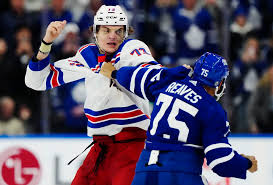NHL Charge Rangers Big Guy Matt Rempe $60 Million under suspension for breaking the rules during… See more…
Near the start of the third period on Saturday night in Toronto, it finally – and inevitably – happened. Leafs’ tough guy Ryan Reaves squared-off at centre ice with Matt Rempe, the hulking New York Rangers rookie. Rempe, a 6ft 7in, 240lbs centre, has one goal and one assist in his first seven games in the NHL.
He also has 37 penalty minutes, five more than he’s spent actually playing on the ice. He’s what most people would call an “enforcer” – a role that in recent years has been more or less phased-out of the NHL.

That’s not to say there aren’t guys around still who are willing to drop the gloves or play a more physical than finesse game – every team has at least one. But what Rempe is doing is different.
Rempe has, so far, spent most of his time fighting. This kind of thing hasn’t been seen in the NHL for years for a few reasons. For one, guys were dying.
The off-ice deaths of enforcers Derek Boogaard, Wade Belak, and Rick Rypien within just months of each other in 2011 were a catalyst for change. In the years since, the case against the so-called “goon” has strengthened.

Multiple studies have, for instance, linked fighting to CTE – even though the NHL commissioner, Gary Bettman, still disputes the link. But there was another change in hockey around the same time: analytics.
In recent years, every player and prospect has become subject to intense data-based analysis, and teams search endlessly for quantifiable metrics – alongside human scouting reports – to chart a path to victory. An enforcer doesn’t easily fit within this new matrix. They rarely generate points and they typically don’t skate well or quickly enough, let alone create things like consistent successful zone entries.
Then there’s the cultural aspect. While the NHL and hockey more broadly has reckoned with the damage done to enforcers’ health, there has also been public pushback on fighting as a spectacle, particularly at the elite level.
Surveys over the last decade show that Canadian fans remain split on the idea of banning fighting in pro hockey outright, but its relative barbarity has served to symbolize deeper attitude issues in the sport, including its well-earned reputation for fostering a culture of silence in the face of things like sexual assault.

Fighting has dropped over the last decade or so – according to one study there were 645 fights in the 2010-11 season, this campaign there are projected to be 282.
That decline, which has led to a faster and more entertaining game – alongside a broader push to make hockey more inclusive to marginalized groups – has been seen as a positive change.
But fighting is a key part of hockey’s “code”, its unwritten rules of conduct and fair play to which players subscribe to govern themselves.
On TNT Saturday night, its NHL panel discussed Rempe’s hit earlier that night on Ilya Lyubushkin, which prompted the fight with Reaves, “Some people might deem that a bit of a charge, but from an old school mentality I’m OK with that hit, but I’m also OK that he had to answer the bell to the other team’s tough guy,” Paul Bissonnette, himself a former NHL enforcer, said.
“I would have liked to have seen a penalty, but he answered the bell, and that’s why I’m OK.” Hockey, and its analysts and fans, have long straddled this line between the “code” and the codified – between hockey’s morals and everyone else’s, imposed from the outside. And the latter have been shaping hockey a lot recently.
For now, this argument between the old way and the new way is being waged mostly by voices inside hockey. But, like other major sports, the NHL is still susceptible to becoming a flashpoint in the larger culture wars. It came close last year during its All Star break in Florida.
An NHL LinkedIn post inviting people to an career fair at its Pathway to Hockey Summit initially specified that participants were required to identify as a member of a marginalized group. Florida’s Republican governor, Ron DeSantis, seized on the event, portraying it as discriminating against white people.
“We do not abide by the woke notion that discrimination should be overlooked if applied in a politically popular manner or against a politically unpopular demographic,” DeSantis’s spokesperson said.
